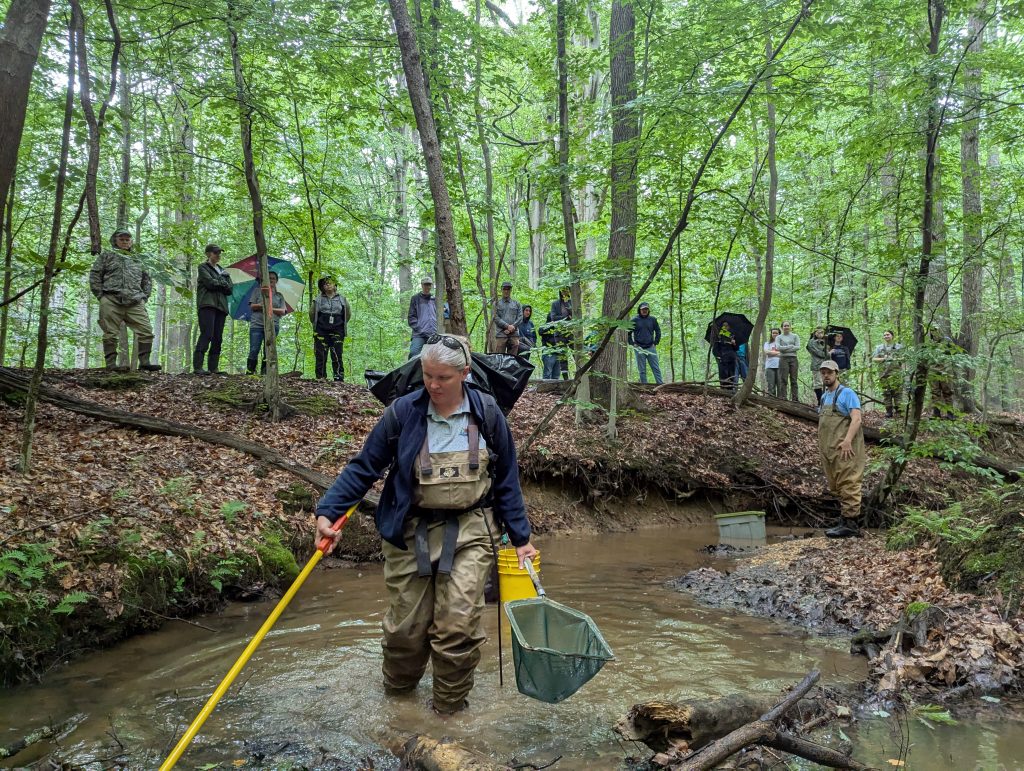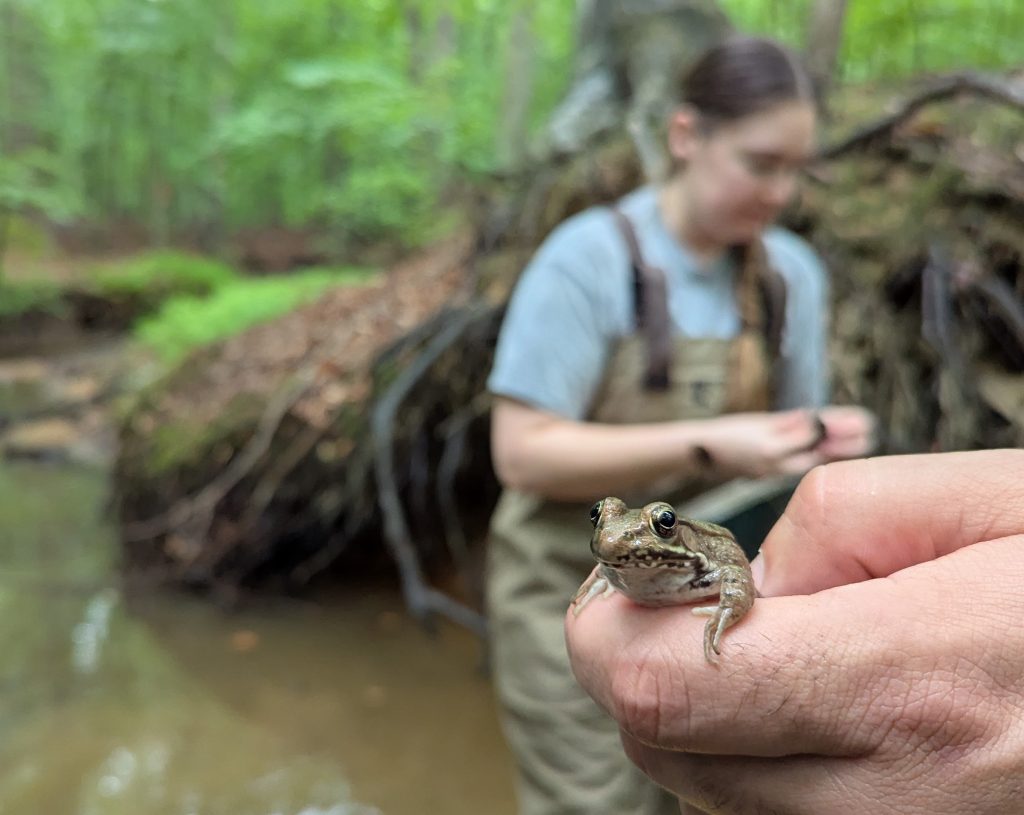The Maryland Biological Stream Survey offers training and certifications at Bowie State University

Maryland Biological Stream Survey scientists demonstrate the process of sampling fish from a stream to a crowd of trainees. Photo by Joe Zimmermann
In some ways, the Maryland Biological Stream Survey Summer Training resembles other education programs. Participants sit through presentations and take tests.
But some of those presentations involve walking through the woods to a nearby stream to watch the process of netting, identifying, and counting fish found there. And studying for the exams involves darting between labs stocked with jars of preserved fish, displays of mussel shells, and tanks for live turtles, snakes, and crayfish.
The Maryland Biological Stream Survey, a Maryland Department of Natural Resources program, holds the training every summer. For the past three years, MBSS has partnered with Bowie State University to conduct the training that takes place in labs, lecture halls, and outdoor areas on the university’s campus.
Collecting data on streams is increasingly important, and this training program is a way to teach people how to do that in Maryland in a standardized way, Jay Kilian, a DNR natural resources biologist, said.
“It’s a way of getting the collective biological monitoring community in Maryland more consistent in the data we collect,” Kilian, who helps coordinate the training, said. “It’s about getting people on the same page, so everybody is doing the same thing.”
Participants come from state agencies, county groups, and consulting programs. Many of these groups are involved in municipal separate storm sewer system—or MS4—regulations, which require that data be collected on the health of streams in local areas before projects take place there. Some are also seeking careers in the environmental field.
Fatima Hardy, an Upper Marlboro resident with a master’s degree in biotechnology, said she appreciated the hands-on nature of the training after seeing biologists demonstrate electrofishing in a small stream.
“I really just like to learn,” she said. “I like to see how the waterways and how our habitat is influenced by our domestic lifestyle.”
As part of the fish sampling demonstration, MBSS biologists showed the proper technique for cordoning off a section of a stream with nets, then demonstrated how a team should proceed through the sample site with a backpack electrofisher to sample the fish that live there. The fish are temporarily immobilized with an electric current, collected with dip nets and buckets, and then identified, counted, and released outside of the site before the team conducts a second pass through the same site.
At this year’s summer training in May, 117 people attended over the course of four days. Participants have the option to attend for one or multiple days, and different days focus on different subjects, including habitat assessments or taxonomy of stream fishes, crayfish, freshwater mussels, reptiles, and amphibians.
By passing written exams and completing field audits, participants can also receive certifications in physical habitat assessment, electrofishing crew leader, fish taxonomy, and freshwater mussel taxonomy. The exams test people’s knowledge on sampling protocols as well as species identification (including rare, threatened, and endangered species), while the audits ensure that those skills are applied correctly in the field.

MBSS scientists display a green frog found in a stream near Bowie State University. Photo by Joe Zimmermann/DNR
MBSS also holds a spring training every year in February, offering certifications in benthic macroinvertebrate sampling and benthic macroinvertebrate laboratory processing and subsampling. Stream surveyors are required to update their certifications regularly in order to monitor streams in Maryland.
The partnership with Bowie State University, a historically black university, allows the training program to access the university’s research and laboratory facilities in addition to fostering a diverse training cohort.
Dr. George Ude, a professor at Bowie State University and the chair of the Department of Natural Sciences, said he was first interested in bringing the MBSS training program to the campus in order to refine the way that students collect samples. He said he’s interested in ways to get more undergraduate students involved in the training program.
“I wanted to expose our students and our faculty to standard methods for sampling and screening,” he said. “We are happy to see the scientists here. It’s created an opportunity. This kind of training is something that’s lacking at universities, and I think MBSS is training people to handle this type of research.”
For more details about certification and training, visit the MBSS website. The Maryland Biological Stream Survey collects data on streams throughout the state. Check the health of your local stream on MBSS’s Stream Health Index Map.
By Joe Zimmermann, science writer for the Maryland Department of Natural Resources
